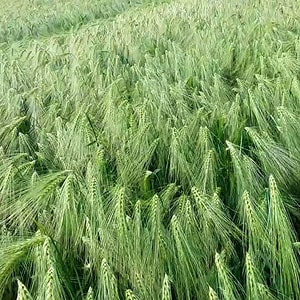Winter barley is a crop that is in demand as feed. In the food industry, barley grain is used as a raw material for the creation of pearl barley and barley groats, as well as egg flour, and brewers make one of the most ancient intoxicating drinks from the grain. The advantages of barley include the high demand for this crop in the world – Ukraine constantly exports barley grain.
The following varieties have become popular in our fields:
- “Selena Star”;
- “Borisfen”;
- “Worker”;
- “Seim”;
- “Aboriginal”;
- “Cinderella”;
- “Fantastic”;
- “Ark.”
It is worth mentioning separately the varieties that are grown for beer production – “Gladys”, “Avalon”, “Philadelphia”, “Scarlett”, “Kangu”, “Corserto”, “Sunshine”.
Winter barley is a cereal whose height reaches 90 cm, hexagonal or tetrahedral spikelets are collected in clusters of three. The fruits are protected by a dense and prickly husk, which must be separated from the grain to produce cereals and flour. Provided that winter barley successfully overwinters, it has a significantly higher yield than its spring counterpart.
However, fields with winter barley make up only 10% of the total area allocated for this crop. Nowadays, quite often winters are frosty, with little or no snow, thaws are replaced by sub-zero temperatures, as a result of which the fields are covered not with fluffy snow, but with an ice crust. In such a situation, crops die and fields have to be replanted in the spring. Winter barley varieties are inferior to wheat in terms of frost resistance.
The main advantage of winter barley is that it is one of the first to be harvested from cereal crops, which makes it possible to prepare high-quality soil for subsequent crops.
Technology for growing winter barley
The ideal field for sowing this crop is fallow. But the soil is suitable for sowing barley for the winter after growing wheat, legumes (both grain and fodder), corn for silage, root crops and melons.
Wheat is a relative of barley, so when sowing in a field where it grew, it is important to carry out integrated prevention against diseases that can affect both grains. Mustard and flax are excellent predecessors; the yield on such fields will be almost the same as on fields after fallow.
A common variant of the predecessor recently is the sunflower. But such fields require a significant amount of fertilizer. The plant will overwinter more easily if it has a strong root system. In order for the soil to form, deep plowing of the soil before sowing is important.
If barley is peeled from the hard film for food use, then the grain is sown unpeeled. Therefore, for seedlings to appear, there must be a lot of moisture in the soil. Based on temperature indicators and weather forecasts regarding rain, you can choose a sowing date of October 1.
If winter is early, then the sowing deadline is October 20. If the autumn turned out to be warm and long, then winter barley can be sown even in December. Barley must go into winter without forming the tubes of the future ear, otherwise it will not survive the winter.
Preparing the sowing mat is mandatory, since without disinfectants the crops will suffer from insect pests and diseases. Without preparing a sowing mat with disinfectants, the number of damaged plants in crops can be up to 45%. For seed treatment, it is preferable to choose combined-action fungicides that can resist various pests, since barley has many enemies in the insect world.
Sowing is done in three ways:
- solid private;
- cross private;
- narrow row.
Row spacing is 15 or 7-8 centimeters. The depth of embedding depends on the type of soil. On heavy soils, sowing to a depth of 3 centimeters is enough, on light soils – up to 8 centimeters. In arid climates, moisture is stored in the deep layers of the soil, so when sowing, climatic conditions must also be taken into account. The more moisture, the finer the seal can be. When using no-till technology, the depth of seed placement is almost always 2-3 centimeters.
Seeding rate – from 3 to 5 million/ha. Thickening of crops leads to the fact that each plant receives insufficient resources, barley grows weak, and diseases are transmitted from one plant to another in this situation without any problems.
The best results and the highest yields are expected with wide-row crops with a seeding rate of 3 million/ha. But not everyone is ready to take risks, because farmers understand that not all seedlings will survive the winter. Therefore, a significant part of agricultural producers rely on narrow-row crops. Immediately after sowing, the soil is rolled onto the field. This will avoid weathering and theft of seeds by birds.
Fertilizers for winter nitrogen
The crop requires, first of all, mineral fertilizers – there is enough residual organic matter for winter barley (the one left after its predecessors). The three main components are nitrogen, phosphorus and potassium.
Phosphorus-potassium fertilizers are applied in advance – when preparing the soil for crops. Nitrogen fertilizers are applied during sowing. The consumption rate of nitrogen fertilizers is for the formation of 1 ton of grain:
- 26 kg nitrogen;
- 24 kg potassium;
- 11 kg phosphorus.
Barley is especially responsive to nitrogen fertilizers, but if you sow the crop in a field where grain legumes or other legumes grew before, then the fertilizer application rate should be halved.
In the spring, crops should be supported by treatment with nitrogen fertilizers, as well as spring harrowing in order to retain maximum moisture in the soil. During the period of milky ripeness, crops are treated with insecticides and fungicides.
Are weeds bad for barley?
This grain crop is able to successfully compete for resources for growth. But there are still recommendations to treat the soil with continuous herbicides in the fall before sowing. Harvesting of winter barley by direct combining is carried out during the period when the grain moisture content is 15%.
After you have learned about how to grow properly, you should think about barley processing. Experienced specialists of the Olis company will help you with this.






























